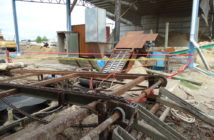Most New Zealanders are acutely aware of the possibility of a natural disaster such as an earthquake, but what’s the best way of helping people affected by such a traumatic event?
 New Zealand Red Cross aims to bridge this knowledge gap with its programme to train people in providing psychological first aid (PFA).
New Zealand Red Cross aims to bridge this knowledge gap with its programme to train people in providing psychological first aid (PFA).
PFA enables people to provide practical and emotional short-term support for individuals, reduce distress and foster the ability to adapt following a disaster or emergency such as an earthquake or traumatic event.
Red Cross developed the PFA training into a one-day practical workshop as part of the lessons learnt from working in Christchurch after the quakes in 2010 and 2011.
Psychological first aid is used in the first hours, days and events following an emergency, building the capacity of people to support others, after an emergency occurs.
Then-Secretary General Tony Paine says PFA is a proven approach to helping people affected by an emergency or traumatic event.
“At its core, PFA is about providing a safe, supportive response to someone who has just been through a sudden disaster and in need of support,” he says.
“PFA helps people feel safe, connected to others, calm and hopeful, able to access physical, emotional, cultural and social support, and feel able to help themselves.
“Just like physical first aid, we recommend PFA as a valuable tool that can make a huge difference to people’s lives.”
PFA training is based on an internationally recognised best-practice model developed by the World Health Organisation and World Vision, and endorsed by over 20 international humanitarian agencies. Red Cross disaster response team members now all receive the training.
The Australian Red Cross, New Zealand Psychological Society, Massey University Joint Centre for Disaster Research, Te Piringa o Te Awakairangi and Le Va all contributed to the training materials, which have been recognised by the Ministry of Health.
The course is recommended for people working in emergency preparedness, response and recovery as well as those coping with emergencies such as first responders and insurance assessors.
“This training is for people who will provide the first and most lasting support, including members within a community or organisation affected by a disaster, accident or crisis.
“It will give you the tools, skills and competencies to help people around you,” Paine explains.
“You’ll be able to support people in your community, workplace or home, who have been impacted by a disaster or emergency.”
Participants learn:
- what is Psychological First Aid?
- who needs it?
- why do they need it?
- when do they need it?
- where can you do it?
- action principles – Look, Listen & Link
- ethics and adapting to particular circumstances.
PFA training courses are priced comparably to one-day Red Cross First Aid courses, Paine explains.
“The eight-hour course costs $1275 (including GST) for the first 10 participants, then $90 per participant up to a maximum of 24 people.”
Essential elements
There are five basic elements to psychological first aid that have been drawn from research on risk and resilience, field experience and expert agreement..
The elements of psychological first aid are to promote:
- safety
- calm
- connectedness
- self-efficacy and group efficacy
- hope.
1. Promote safety
- Remove from, or reduce exposure to, threat of harm.
- Help people meet basic needs for food, water, shelter, financial and material assistance.
- Help people obtain emergency medical attention.
- Provide physical and emotional comfort.
- Provide repeated, simple and accurate information, in a range of methods, on
how to get these basic needs met.
2. Promote calm
- Stabilise people who are overwhelmed or disoriented.
- Provide an environment, as far as practical, removed from stressful
situations or exposure to sights, sounds and smells of the emergency. - Listen to people who wish to share their stories and emotions, without forcing
them to talk. - Remember that there is no right or wrong way to feel.
- Be friendly and compassionate even if people are being difficult.
- Offer accurate information about the disaster or trauma and the relief efforts
underway to help survivors understand the situation. - Provide information on stress and coping.
- When they express fear or worry, remind people (if you know) that more help and services are on the way.
3. Promote connectedness
- Help people contact friends and loved ones.
- Keep families together.
- Keep children with parents or other close relatives whenever possible.
- Help establish contacts with support people (friends, family or community helping resources).
- Respect cultural norms regarding gender, age and family structures.
- Offer practical help to people to address immediate needs and concerns.
- Provide information and direct people to those services that are available.
- Link people with available services.
- Respect cultural norms regarding gender, age, family structures and religion.
4. Promote self-efficacy
- Engage people in meeting their own needs.
- Assist with decision making, help them to prioritise problems and solve them.
- 5. Promote hope
- Convey expectancy that people will recover.
- Be there/be willing to help.
- Reassure people that their feelings are normal.



